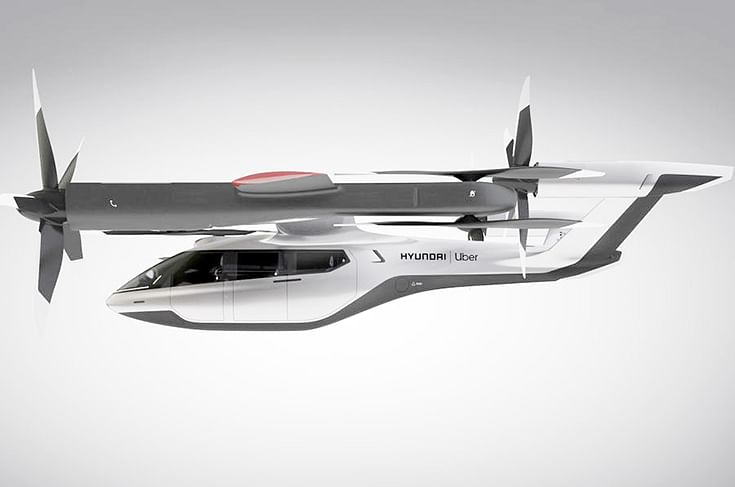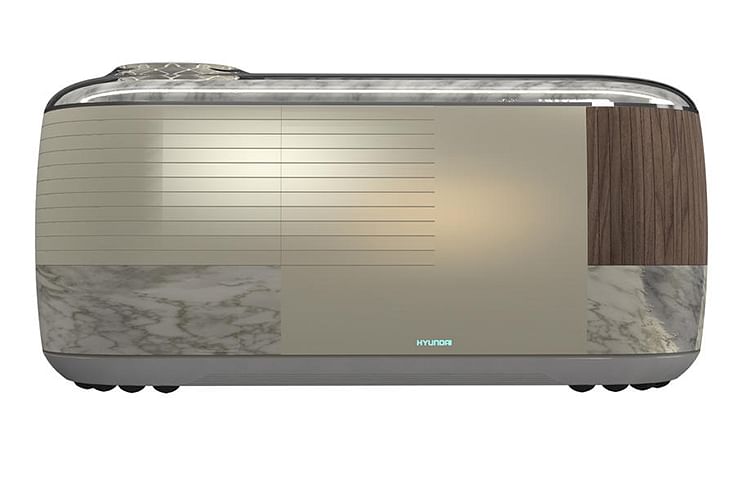Hyundai and Uber showcase electric flying taxi concept at CES 2020
Korean firm teams up with ride sharing giant to showcase bold urban-focused aircraft at CES 2020 in Las Vegas.
Hyundai has teamed up with ride sharing service Uber to develop a Personal Air Vehicle (PAV) concept that could be used as an electric flying taxi in the future.
The S-A1 concept, unveiled at CES in Las Vegas, can carry up to four passengers, is capable of vertical take-off and landing and has a cruising speed of 180mph at an altitude of 1000-2000 feet above ground. Hyundai said the machines will initially be piloted but are capable of becoming fully autonomous eventually.
The machine will be developed and produced by Hyundai, with Uber’s nascent air taxi division providing “airspace support services”, links to ground-based transport options and customer interfaces. Hyundai is the first firm to join the Uber Elevate initiative to develop mass-scale private air transport.
While a pure design concept at this stage, the S-A1 is intended to be capable of trips of up to 60 miles and is capable of being recharged in five to seven minutes at peak times. It will be propelled by multiple small propellers positioned around the frame; Hyundai says this layout both reduces noise compared to a large helicopter rotor and aids safety by minimising the impact of any single point of failure.

S-A1 concept can carry up to 4 passengers, is capable of vertical take-off and landing and has a cruising speed of 180mph at 1,000-2,000 feet above ground.
Hyundai presented the S-A1 at CES as part of a wider "vision for urban mobility", showcasing potential transport solutions for cities in the future.
The concept includes a Purpose Built Vehicle (PBV), an electric autonomous shuttle-style vehicle that Hyundai says has been inspired by San Francisco cable cars.

Purpose Built Vehicle is an electric autonomous shuttle-style vehicle that Hyundai says has been inspired by San Francisco cable cars.
The PBV, which can be between four and six metres long, is conceived with a separate chassis and upper bodies, allowing the interior to be customised for various purposes.
Examples of potential uses given by Hyundai include a restaurant, coffee shop and hotel, with those services available as users are taken to their destinations. It could also be customised to individual needs and used as a living space.
Hyundai says the PBV can be charged while in use by other PBVs that function as battery packs.
The PAV and PBV concepts are linked in Hyundai’s proposed mobility system by a Hub, a new ‘mobility space’ that has a ‘skyport’ for the PAV on top, with PBV docking stations underneath. Hyundai believes the Hubs can also serve as multi-function community spaces.
RELATED ARTICLES
Skoda begins sale of made-in-India CKD Kushaq in Vietnam
Before production started, pre-series Kushaq vehicles covered over 330,000 kilometres on a variety of Vietnamese roads a...
Six Japanese companies join forces to expand use of recycled materials in new vehicles
Denso, Toray Industries, Nomura Research Institute, Honda Motor, Matec Inc and Rever Corporation have set up the BlueReb...
BYD selects Voestalpine as steel supplier for its Hungarian plant
The announcement of the Austrian steelmaker as a supplier demonstrates BYD’s strategic plan to source from high-quality,...





 07 Jan 2020
07 Jan 2020
 6333 Views
6333 Views














 Autocar Professional Bureau
Autocar Professional Bureau




